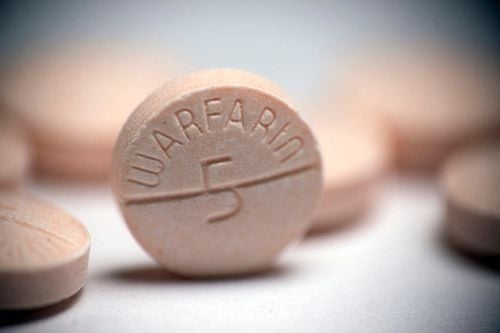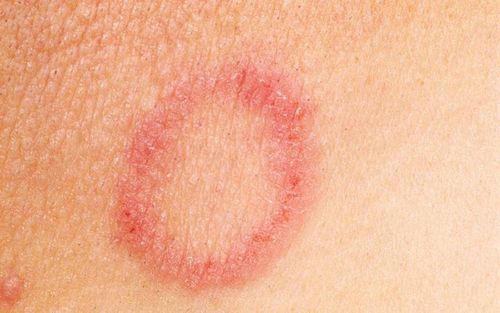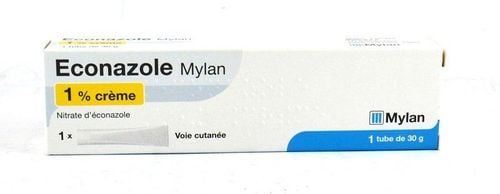This is an automatically translated article.
Fluconazole is a common antifungal drug. This active ingredient is in Salgad 150mg. So what is Salgad and how is it indicated for use?
1. What is Salgad?
Salgad contains the antifungal active ingredient Fluconazole 150mg. Fluconazole in Salgad is a new generation antifungal drug in the form of a synthetic triazole. The antifungal mechanism of Salgad 150mg is to inhibit the cytochrome P450-14-α-demethylase enzyme, thereby preventing the synthesis of ergosterol in the fungal cell membrane. As a result, the cell membrane of the fungus changes its permeability, leading to the loss of essential substances (such as amino acids, potassium ...) and reduced absorption of precursor molecules such as purines, pyrimidines... Salgad has no effect. similar effect on cholesterol synthesis in humans.
Pharmacokinetics of Salgad 150mg:
Salgad 150mg is well absorbed from the gastrointestinal tract and is not affected by food, the bioavailability of oral fluconazole is equal to or more than 90% of that of intravenous administration. The maximum concentration of fluconazole in plasma is reached after 1 - 2 hours and the target concentration is reached within 5-7 days of using Salgad 150mg; Salgad is widely distributed in body tissues and fluids. Concentrations in breast milk, synovial fluid, saliva, respiratory secretions, vaginal and peritoneal fluids were equal to those in blood. The concentration of fluconazole in the cerebrospinal fluid is only 50% to 90% of the plasma concentration, even when the meninges are not inflamed. Therefore, Salgad 150mg is widely indicated for fungal infections in various organs; Salgad is excreted unchanged in the urine at a rate of at least 80%. Salgad's half-life is approximately 30 hours, making it suitable for a single daily dose.
2. Indications of the drug Salgad 150mg
Indications of the drug Salgad 150mg in the following cases:
Salgad treatment of Candida infections in the vulva and/or vagina; Salgad 150mg is used to treat candida infections of the mouth, pharynx, esophagus, urinary tract, peritoneum and other serious systemic candida infections such as candidaemia, pulmonary candidiasis or disseminated candidiasis; Meningitis caused by Cryptococcus neoformans ; Fungal diseases caused by Blastomyces, Coccidioides immitis and Histoplasma; Salgad is also used for the prevention of Candida infections in immunocompromised patients, bone marrow transplant patients undergoing chemotherapy or radiation therapy, cancer or HIV/AIDS patients.
3. Instructions for using Salgad 150mg
Dosage and duration of treatment of Salgad 150mg depends on many factors such as the type of fungus causing the disease, kidney function and the patient's ability to respond. When treating fungal infections, patients should take Salgad 150mg continuously according to the instructions of the doctor until the clinical signs and laboratory results are completely cured. may increase the risk of disease recurrence. For cases of HIV infection and cryptococcal meningitis, the course of treatment with Salgad 150mg should be maintained long-term to prevent recurrence.
Dosage of Salgad for infants:
Under 2 weeks old: 3-6 mg/kg/time, used 72 hours apart; 2-4 weeks old: 3-6 mg/kg/time, given 48 hours apart. Dosage of Salgad for children:
Prophylactic purposes: 3 mg/kg/day for superficial fungal infections and 6-12 mg/kg/day for systemic fungal infections; Treatment: 6mg/kg/day, persistent cases may need up to 12mg/kg/day, divided into 2 doses. The maximum dose is 600mg per day (no more than 4 Salgad 150mg tablets). Dosage of Salgad for adults:
Vaginal candidiasis: Use only 1 Salgad 150mg tablet. The risk cases want to prevent recurrence can use 1 Salgad 150mg tablet, 1 time per month for 4-12 months; Oral and oropharyngeal candidiasis: The recommended dose is 1 Salgad 150mg tablet once a day, for 1 to 2 weeks of treatment; Esophageal Candida infection: Take 1 Salgad 150mg tablet, once a day continuously for at least 3 weeks and can be maintained for at least 2 weeks when symptoms have disappeared; Systemic candidiasis: The first day, take 3 Salgad 150mg tablets once a day, then take 1 Salgad 150mg tablet once a day for at least 4 weeks and for another 2 weeks after the symptoms are gone; Cryptococcal meningitis: First day take 3 Salgad 150mg tablets once a day, the following days take 1-3 tablets/time/day for at least 6-8 weeks until CSF culture results negative results. For HIV-infected patients, to avoid relapse, Salgad 150mg should be used at a dose of 1 tablet/time/day for a long time; Prophylaxis of fungal infections: It is recommended to take 3 Salgad 150mg tablets once a day. For high-risk patients with severe granulocytopenia (neutrophil count less than 500/mm3), Salgad should be started prophylactically a few days before the neutrophil count falls on laboratory tests and continued. with the same dose for an additional 7 days until the neutrophil count increased more than 1000/mm3. Dosage of Salgad 150mg for patients with renal failure:
Patients taking a single dose to treat vulvovaginal candidiasis do not need to adjust the dose; Patients requiring multiple doses of Salgad require dose adjustment as follows: Creatinine clearance > 50ml/min: Use 100% of the recommended dose; Creatinine clearance 11-50ml/min: Use 50% recommended; Hemodialysis: Use 100% of the recommended dose after each dialysis session.
4. Contraindications of Salgad
Salgad is contraindicated in the following cases:
Patients with hypersensitivity to Fluconazole and other azole antifungals (such as Ketoconazole, Miconazole and Clotrimazol); Patients who are allergic to any ingredient of Salgad 150mg.
5. Drug interactions of Salgad 150mg
Fluconazole in Salgad 150mg increases the plasma concentration of some drugs when used concurrently, including sulfonylurea antidiabetics (Tolbutamide, Glyburide, Glipizid), Phenytoin (epileptic drug), Theophylline ( asthma medicine), Astemizole (antihistamine), coumarin anticoagulants (Warfarin), antivirals (Zidovudin), Cisaprid, Tacrolimus and Cyclosporin... Thus increasing the risk of side effects and toxicity of the above drugs; Combining Salgad and Rifampicin may affect the pharmacokinetics of both drugs. In particular, Rifampicin reduces the absorption and half-life of Salgad, thus requiring appropriate dose adjustment; There have been reports of interactions when Salgad was co-administered with rifabutin or Salgad with zidovudine in HIV patients. Fluconazole increases plasma concentrations and area under the curve (AUC) of rifabutin and its major metabolites.
6. Salgad side effects
Undesirable effects occur in about 5-30% of patients who have been taking Salgad for at least 7 days or longer, of which the rate of discontinuation is 1-2.8%. Patients only taking a single dose to treat vulvovaginal candidiasis - vaginal candidiasis experienced undesirable effects with the rate of about 26-31%. In addition, all adverse events were reported more commonly in HIV-infected patients (21%) than in uninfected patients (13%). However, it is difficult to accurately assess and determine the relationship between Salgad and unwanted effects, because this product is often indicated for patients with severe underlying medical conditions and who have taken multiple drugs simultaneously. difference.
Common side effects of Salgad 150mg :
Headache, dizziness (about 2% of patients); Nausea, vomiting, abdominal pain, diarrhea (about 1.5 - 8.5%). Some rare side effects of Salgad:
Mild and transient elevation of liver enzymes and serum bilirubin (1.5 to 3 times upper limit of normal); Rash, itchy skin; Eosinophilia, anemia, neutropenia, thrombocytopenia; Rarely, elevation of liver enzymes 8 times or more above the upper limit of normal and necessitates discontinuation of Salgad; Scaly skin (common in patients with AIDS and cancer), Stevens-Johnson syndrome; Fever; Edema; Pleural effusion; Urinating less; Lower blood pressure; Hypokalemia; Defensive shock.
7. Some cautions when taking Salgad
Caution should be taken when administering Salgad 150mg to patients with impaired liver or kidney function, cardiac arrhythmias, prolongation of the QT interval on the electrocardiogram;
Use of Salgad in pregnant women and nursing mothers:
Pregnancy: To date, there are no adequate studies on the use of Fluconazole in pregnant women. Therefore, Salgad 150mg should only be used in this patient when the benefit outweighs the possible risk to the fetus; Lactation: Fluconazole is excreted in milk at concentrations similar to those in plasma, so Salgad 150mg is contraindicated in nursing mothers. Driving and operating machines: Salgad 150mg medicine can cause headaches, dizziness, so it should be used with caution in people who are driving and operating machinery. Salgad contains the active ingredient fluconazole 150mg. The drug is indicated for the treatment and prevention of certain fungal infections. To ensure effective treatment and avoid unwanted side effects, patients need to take the medicine exactly as directed.
Follow Vinmec International General Hospital website to get more health, nutrition and beauty information to protect the health of yourself and your loved ones in your family.
Please dial HOTLINE for more information or register for an appointment HERE. Download MyVinmec app to make appointments faster and to manage your bookings easily.













